DARK NIGHTS
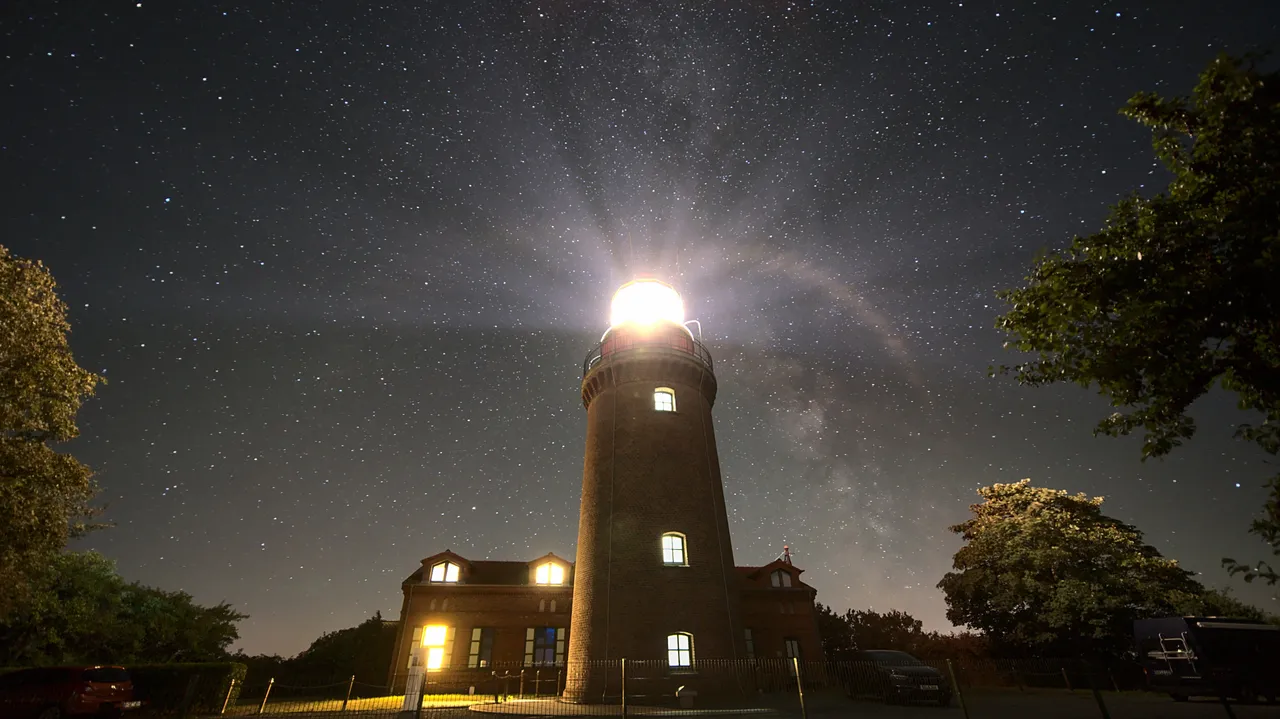
📷 Nikon D750 - Laowa 12/2,8 - f2,8 - ISO 3200 - 30 seconds
As a Berliner, I see all kinds of things every day, but never such a starry sky. The light and air pollution in Berlin is far too great for that. Even if I can find Stella Polaris in the sky without help and can distinguish an aeroplane from the ISS, I am far from being an astrophotographer. And quite honestly, in the long run it would bore me to photograph only stars.
The images in this post were each taken in one exposure. In image processing I sharpened, denoised and changed the crop on some of the images, nothing more.
Als Berliner sehe ich jeden Tag alles Mögliche, aber in keinem Fall einen derartigen Sternenhimmel. Dafür ist die Licht- und Luftverschmutzung in Berlin viel zu groß. Auch wenn ich Stella Polaris ohne fremde Hilfe am Himmel finde und ein Flugzeug von der ISS unterscheiden kann, bin ich weit davon entfernt ein Astrofotograf zu sein. Und ganz ehrlich, auf Dauer würde es mich langweilen nur Sterne zu fotografieren.
Die Bilder in diesem Beitrag wurden in jeweils einer Belichtung aufgenommen. In der Bildbearbeitung habe ich die Bilder geschärft, entrauscht und bei einigen Bildern den Schnitt geändert, mehr nicht.

📷 Nikon D750 - Laowa 12/2,8 - f2,8 - ISO 800 - 30 seconds
I took the first two pictures at Bastorf lighthouse. It stands between Kühlungsborn and Rerik. In most cases, I first look at the locations where I want to take pictures at night in daylight. In this case, I did without and arrived at the lighthouse after dark. The lighthouse itself is actually very photogenic. I also like the fact that some of the windows of the apartment building and the windows of the lighthouse staircase are illuminated. However, the fence and the cars parked on the property bother me a lot. If I had looked at it before in daylight, I probably wouldn't have gone to this lighthouse again at night. At 20.8 metres, the lighthouse is not very high. For this reason, some of the bright light hit the lens directly and painted these funny light effects in the picture. The two pictures turned out quite well anyway, I think, but I was a bit frustrated and then went to the Gespensterwald Nienhagen again.
Die ersten beiden Bildern habe ich am Leuchtturm Bastorf aufgenommen. Dieser steht zwischen Kühlungsborn und Rerik. In den meisten Fällen schaue ich mir die Locations, an denen ich nachts fotografieren will, zuerst bei Tageslicht an. In diesem Fall habe ich darauf verzichtet und kam erst in der Dunkelheit am Leuchtturm an. Der Leuchtturm selbst ist eigentlich sehr fotogen. Mir gefällt auch, dass einige der Fenster des Wohnhauses sowie die Fenster des Treppenhauses des Leuchtturms beleuchtet sind. Allerdings stören mich der Zaun und die auf dem Grundstück parkenden Autos sehr. Hätte ich mir das zuvor bei Tageslicht angesehen wäre ich wahrscheinlich nachts nicht noch einmal zu diesem Leuchtturm gefahren. Der Leuchtturm ist mit 20,8 Metern nicht sehr hoch. Aus diesem Grund ist ein Teil des hellen Lichts direkt auf das Objektiv getroffen und hat diese lustigen Lichteffekte ins Bild gemalt. Die beiden Bilder sind zwar trotzdem ganz gut geworden, wie ich finde, aber ich war etwas frustriert und fuhr dann noch einmal in den Gespensterwald Nienhagen.
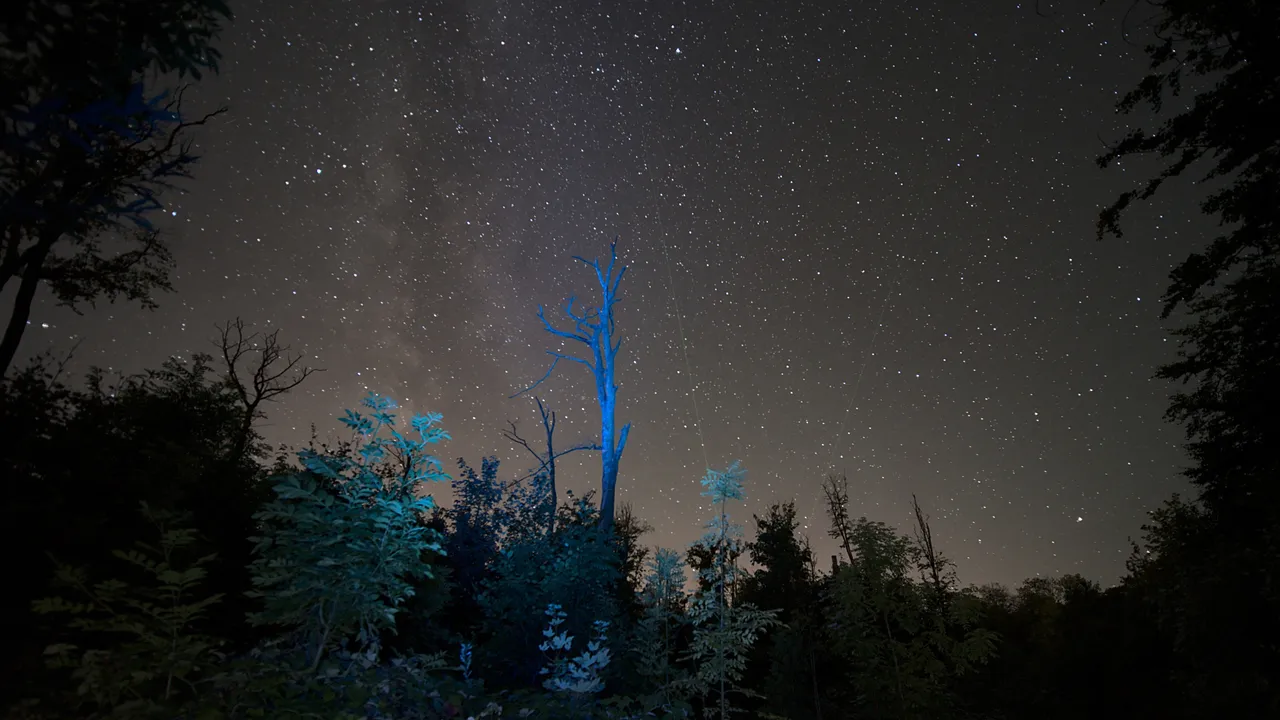
📷 Nikon D750 - Laowa 12/2,8 - f2,8 - ISO 3200 - 30 seconds
In the Ghost Forest I had discovered several dead trees a few days ago. I wanted to stage these together with the starry sky. I illuminated the dead trees with the Noctigon DM11 with a blue colour filter. Unfortunately, I couldn't get close to the trees because there are brambles growing all over the place. The lighting of the trees was therefore a bit difficult. First I took some pictures with high ISO values and 30 seconds exposure time each.
Im Gespensterwald hatte ich vor einigen Tagen mehrere abgestorbene Bäume entdeckt. Diese wollte ich gemeinsam mit dem Sternenhimmel in Szene setzen. Ich beleuchtete die abgestorbenen Bäume mit der Noctigon DM11 mit blauem Farbfilter. Leider kam ich nicht nah an die Bäume heran weil dort flächendeckend Brombeersträucher wachsen. Die Beleuchtung der Bäume gestaltete sich somit etwas schwierig. Zuerst habe ich einige Aufnahmen mit hohen ISO Werten und jeweils 30 Sekunden Belichtungszeit aufgenommen.

📷 Nikon D750 - Laowa 12/2,8 - f2,8 - ISO 3200 - 30 seconds
In one of the shots I captured two shooting stars, so I have no other explanation for the two streaks of light. They are very close to each other and run parallel. I had never seen anything like this before.
Bei einer der Aufnahmen habe ich zwei Sternschnuppen aufgenommen, also ich habe keine andere Erklärung für die beiden Lichtstreifen. Diese liegen sehr dicht nebeneinander und laufen parallel. So etwas hatte ich bis dahin noch nie gesehen.

Perhaps there is another explanation for this phenomenon. If it were just a trace, I would be sure it was a shooting star. But two so close together?
Vielleicht gibt es ja auch eine andere Erklärung für dieses Phänomen. Wenn es nur eine Spur wäre, wäre ich mir sicher, dass es sich um eine Sternschnuppe handelt. Aber zwei so nah nebeneinander?
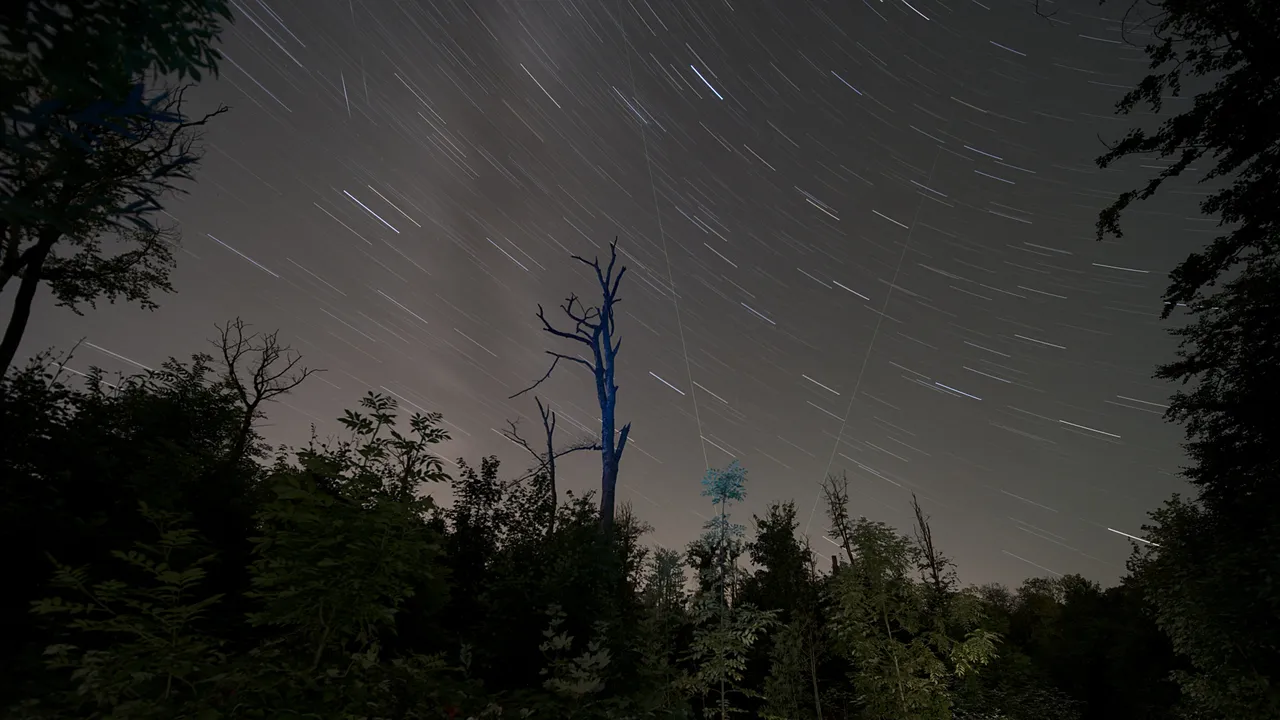
📷 Nikon D750 - Laowa 12/2,8 - f5,6 - ISO 200 - 1199 seconds
Next I wanted to take a picture with star trails. So I set the ISO to 200 and the aperture to 5.6. I lit the dead tree again with blue light and the rest of the scene with the Emisar D18. Because of the clearly visible Milky Way, the image does not look quite as I had hoped.
Als nächstes wollte ich ein Bild mit Sternenspuren aufnehmen. Ich stellte also den ISO auf 200 und die Blende auf 5,6. Ich beleuchtete den abgestorbenen Baum wieder mit blauem Licht und den Rest der Szene mit der Emisar D18. Durch die deutlich sichtbare Milchstraße sieht das Bild nicht ganz so aus wie erhofft.

In this image, three shooting stars can be seen, again close together. In the previous image, I only saw the light trails when I looked at the image on the camera display. In this image, I saw two of the shooting stars during the exposure. The distance between them was several minutes. But here, too, I find it very unusual that the shooting stars were travelling so close to each other in the same direction.
In diesem Bild sind drei Sternschnuppen, auch wieder nah beeinander, zu sehen. Beim vorherigen Bild hatte ich die Lichtspuren erst gesehen als ich das Bild auf dem Kameradisplay betrachtet hatte. Bei diesem Bild habe ich zwei der Sternschnuppen während der Belichtung gesehen. Der Abstand dazwischen betrug mehrere Minuten. Aber auch hier finde ich es sehr ungewöhnlich, dass die Sternschnuppen so nah beienander in die gleiche Richtung unterwegs waren.

📷 Nikon D750 - Laowa 12/2,8 - f2,8 - ISO 1600 - 30 seconds
I went a little deeper into the forest to the next dead trees. I also illuminated them again with blue light. I was a little surprised that there were no hornets and that everything else in the forest was quite quiet. Suddenly a pack of wild boars appeared nearby. That wouldn't have been dramatic, but two boars were arguing very loudly. I didn't feel like getting involved in this quarrel. So I grabbed my backpack and tripod and moved away towards the road. I was accompanied by a fox, which obviously didn't want to get into a fight with the boars either. Just before I reached the road, he looked at me again and then turned away. So the nocturnal photo session was over.
Ich ging etwas tiefer in den Wald zu den nächsten abgestorbenen Bäumen. Auch hier beleuchtete ich diese wieder mit blauem Licht. Ich war schon etwas verwundert, dass keine Hornissen da waren und auch ansonsten alles im Wald recht ruhig war. Plötzlich tauchte in der Nähe ein Rudel Wildschweine auf. Das wäre eigentlich nicht dramatisch, allerdings hatten zwei Keiler sehr lautstarken Streit. Ich hatte keine Lust auf eine Beteiligung an diesem Streit. Ich schnappte mir also Rucksack und Stativ und entfernte mich Richtung Straße. Dabei wurde ich von einem Fuchs begleitet, der offensichtlich auch keine Lust auf die Schlägerei unter den Wildschweinen hatte. Kurz vor der Straße blickte er mich noch einmal an und schwenkte dann ab. Die nächtliche Fotosession war also beendet.

Under what circumstances do such images succeed?
As already mentioned above, such images only succeed when light pollution is low. Although the city of Rostock and many other illuminated places are nearby, I took most of the pictures in the direction of the Baltic Sea. The illuminated places were therefore behind the camera. The moon can also make such shots impossible. But it had already set. So it was very dark. Without a flashlight I would hardly have found my way through the forest. Next, a clear sky is needed. Air pollution also limits the clear view of the stars.
Wie bereits oben erwähnt gelingen solche Bilder nur wenn die Lichtverschmutzung gering ist. In der Nähe sind zwar die Großstadt Rostock und viele weitere beleuchtete Orte, die meisten Aufnahmen hatte ich allerdings in Richtung Ostsee aufgenommen. Die beleuchteten Orte lagen also hinter der Kamera. Auch der Mond kann solche Aufnahmen unmöglich machen. Dieser war allerding bereits untergegangen. Es war also sehr dunkel. Ohne Strinlampe hätte ich den Weg duchr den Wald kaum gefunden. Als nächstes ist ein klarer Himmel nötig. Auch Luftverschmutzung schränkt die klare Sicht auf die Sterne ein.

What equipment is needed?
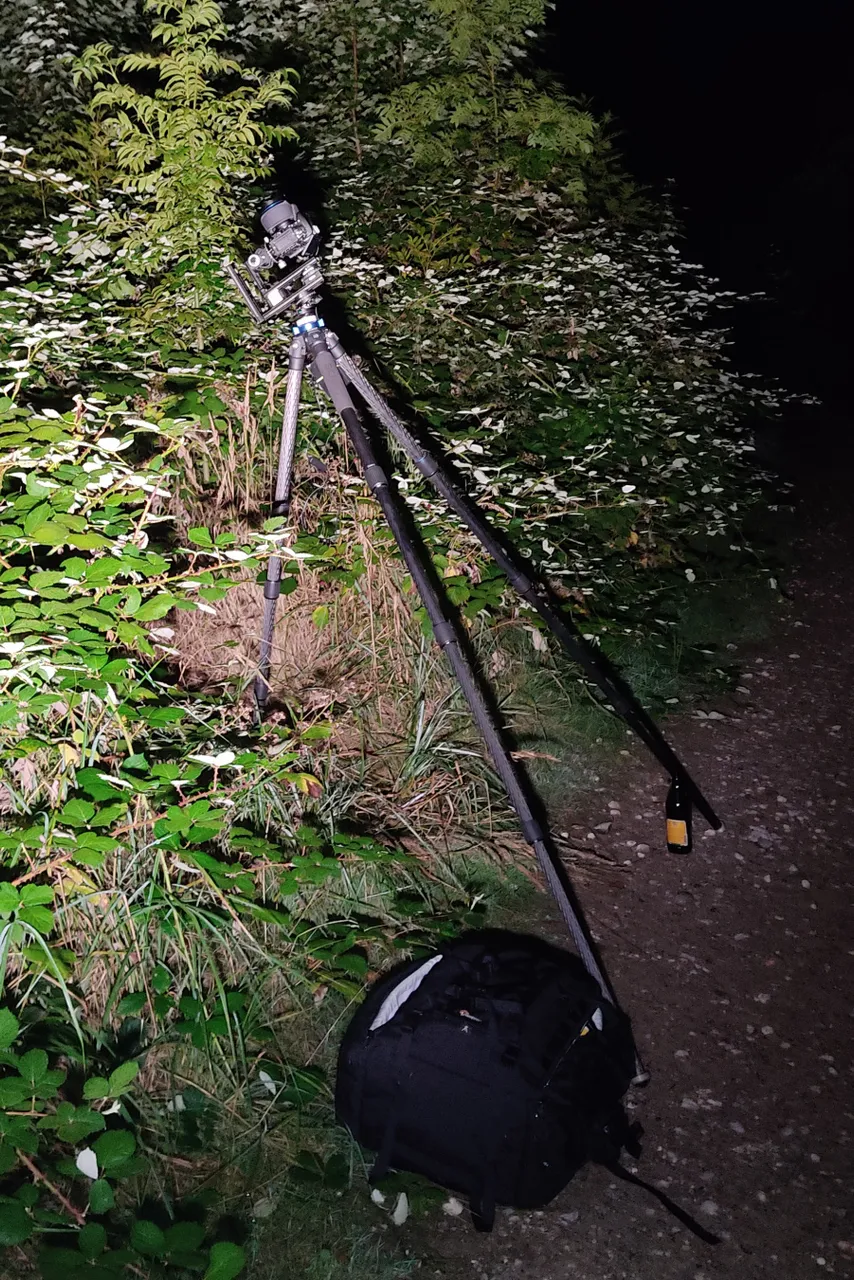
First of all, a secure stand for the camera is necessary. Without a good tripod, in my case a Benro TMA48CXL, such shots hardly succeed. I use the Nikon D750 for these pictures. This has a high dynamic range and very good noise behaviour. Especially when you work with high ISO values, the differences to other cameras quickly become visible. With many cameras, the image noise is so strong that the images can hardly be saved in image processing. A short focal length is necessary so that you can expose for as long as possible without recording star trails. The so-called 500 rule gives the maximum exposure time with which you can work. 500 is divided by the focal length. So with the Laowa 12mm I can expose for a maximum of 41.6 seconds. Most of the time, however, I limit myself to 30 seconds. The 500 rule applies to the 35 mm format, with crop cameras the crop factor must be taken into account. In this case, then, as 500 / (1.5 * 12) = 27.7 seconds. In addition, the lens should have good imaging properties even at open aperture and have low distortion. To prevent the front lens of the lens from fogging up, I mount a heating collar as far forward as possible on the lens. Especially near bodies of water like the Baltic Sea, the lens would fog up very quickly at night, making the pictures unusable.
Zuerst einmal ist ein sicherer Stand der Kamera nötig. Ohne ein gutes Stativ, in meinem Fall ein Benro TMA48CXL, gelingen solche Aufnahmen kaum. Ich verwende für diese Bilder die Nikon D750. Diese hat einen hohen Dynamikumfang und ein sehr gutes Rauschverhalten. Gerade wenn man mit hohen ISO Werten arbeitet werden die Unterschiede zu anderen Kameras schnell sichtbar. Bei vielen Kameras ist das Bildrauschen so stark, dass die Bilder in der Bildbearbeitung kaum noch zu retten sind. Damit man möglichst lange belichten kann ohne Sternenspuren aufzunehmen ist eine kurze Brennweite nötig. Mit der sogenannten 500er Regel ergibt sich die maximale Belichtungszeit, mit der man arbeiten kann. Dabei wird 500 durch die Brennweite geteilt. Mit dem Laowa 12mm kann ich also maximal 41,6 Sekunden belichten. Meist beschränke ich mich allerdings auf 30 Sekunden. Die 500er Regel gilt für das Kleinbildformat, bei Crop Kameras muss der Cropfaktor berücksichtigt werden. In diesem Fall dann also 500 / (1,5 * 12) = 27,7 Sekunden. Darüber hinaus sollte das Objektiv auch bei offener Blende gute Abbildungseigenschaften haben und eine geringe Verzeichnung aufweisen. Damit die Frontlinse des Objektivs nicht beschlägt montiere ich eine Heizmanschette möglichst weit vorn am Objektiv. Gerade in der Nähe von Gewässern wie der Ostsee würde die Linse nachts sehr schnell beschlagen und somit die Bilder unbrauchbar werden.

WHAT IS LIGHT PAINTING?

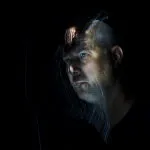
LICHTKUNSTFOTO
If you like my art visit www.lichtkunstfoto.de for more Light Art Photography and informations about Light Painting. Join me on Flickr Twitter



For more great Light Art Photography, Light Painting and inspiration check these light painters: @marlasinger666 @fadetoblack @fastchrisuk @dawnoner @oddballgraphics @martbarras @stepko @rod.evans.visual @yo-hoho @maxpateau @gunnarheilmann @neilru75 @maximepateau @ryuslightworks @lightstabeu @candelart @lacelight @theballoflight

WE ARE LIGHT PAINTERS
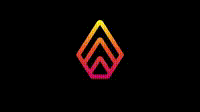
To help and support the LightPainters community here on Hive I would appreciate your delegation of HivePower. Any amount is appreciated. It does not require much to get started, we are happy for any gesture. @lightpainters
How to delegate?
Delegate 50HivePower, [50HP]
Delegate 250HivePower, [250HP]
Delegate 500HivePower, [500HP]
Delegate 1000HivePower, [1000HP]
All the Hive Power will help to upvote the artist's contribution as part of the LightPainters community.